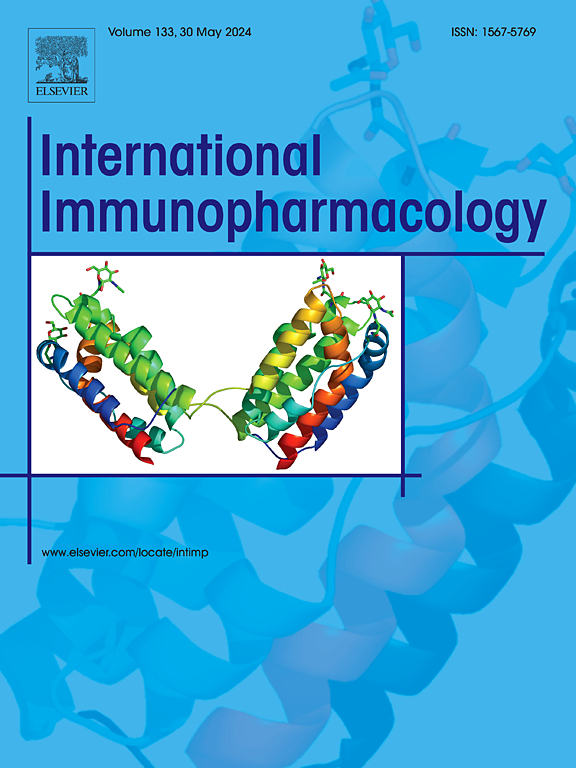Mitigating PCOS progression: The protective effect of C-phycocyanin on ovarian granulosa cell pyroptosis via the NRF2/NLRP3/GSDMD pathway
IF 4.8
2区 医学
Q2 IMMUNOLOGY
引用次数: 0
Abstract
Background
Pyroptosis is a proinflammatory cell death process that contributes to inflammatory diseases. C-Phycocyanin (C-PC) is a water-soluble protein pigment primarily derived from cyanobacteria, and it exhibits anti-inflammatory effects. However, the role of natural C-PC in pyroptosis in human ovarian granulosa cells (GCs), particularly in conditions like polycystic ovary syndrome (PCOS), remains unclear. This study investigates the effects of C-PC on pyroptosis and its relevance to PCOS.
Methods
Here dehydroepiandrosterone (DHEA) was used to induce PCOS in a mouse model that was characterized by an irregular oestrous cycle, cystic follicles and an elevated serum hormone level. DHEA treatment was used to induce GC pyroptosis. Scanning electron microscopy (SEM) was used to determine cell morphology. The expression levels of key proteins for oxidative stress and pyroptosis, including nuclear factor erythroid 2-related factor 2 (NRF2), NLR family of pyrroline-containing structural domain 3 (NLRP3) inflammasomes, cleaved caspase-1, and N-GSDMD were investigated in vivo and in vitro by Western blotting and immunofluorescence staining.
Results
C-PC restored the estrous cycle in PCOS mice, reduced testosterone levels, and decreased cystic follicles. It attenuated PCOS progression by reducing oxidative stress level and suppressing GCs pyroptosis. At the cellular level, C-PC inhibited DHEA-induced GC pyroptosis by blocking NLRP3 inflammasome activation and lowering ROS, effects reversed by the NRF2 inhibitor (ML385). Molecular docking analysis and CETSA suggested that C-PC may protect against PCOS by activating the NRF2 pathway or by indirectly binding to the Ser27 site of GSDMD. In addition, C-PC suppressed ROS/p38-MAPK activation induced by DHEA, and p38-MAPK agonists diminished its effect on NLRP3 inflammasome activity and GC pyroptosis protection.
Conclusion
C-PC exerts a protective effect on GC pyroptosis through the NRF2/NLRP3/GSDMD and ROS/p-38 MAPK pathways, highlighting its potential to mitigate inflammation and its relevance to reproductive health issues like PCOS.
缓解PCOS进展:c -藻蓝蛋白通过NRF2/NLRP3/GSDMD途径对卵巢颗粒细胞焦亡的保护作用
背景:焦亡是一种促进炎症的细胞死亡过程,可导致炎症性疾病。c -藻蓝蛋白(C-PC)是一种水溶性蛋白色素,主要来源于蓝藻菌,具有抗炎作用。然而,天然C-PC在人卵巢颗粒细胞(GCs)焦亡中的作用,特别是在多囊卵巢综合征(PCOS)等情况下,仍不清楚。本研究探讨C-PC对焦亡的影响及其与PCOS的相关性。方法采用脱氢表雄酮(DHEA)诱导小鼠多囊卵巢综合征(PCOS)模型,其特征是排卵周期不规则、卵泡囊和血清激素水平升高。DHEA诱导GC焦亡。用扫描电镜(SEM)观察细胞形态。采用Western blotting和免疫荧光染色法检测氧化应激和焦亡关键蛋白NRF2、NLR家族pyroline -containing structural domain 3 (NLRP3)炎性小体、cleaved caspase-1、N-GSDMD在体内和体外的表达水平。结果sc - pc恢复PCOS小鼠的发情周期,降低睾酮水平,减少囊泡。它通过降低氧化应激水平和抑制GCs焦亡来减轻PCOS的进展。在细胞水平上,C-PC通过阻断NLRP3炎性体激活和降低ROS来抑制dhea诱导的GC焦亡,NRF2抑制剂(ML385)逆转了这一作用。分子对接分析和CETSA表明,C-PC可能通过激活NRF2通路或间接结合GSDMD的Ser27位点来保护PCOS。此外,C-PC抑制DHEA诱导的ROS/p38-MAPK活化,p38-MAPK激动剂降低其对NLRP3炎性体活性和GC焦亡保护的作用。结论c - pc通过NRF2/NLRP3/GSDMD和ROS/p-38 MAPK通路对GC焦亡具有保护作用,突出了其减轻炎症的潜力及其与PCOS等生殖健康问题的相关性。
本文章由计算机程序翻译,如有差异,请以英文原文为准。
求助全文
约1分钟内获得全文
求助全文
来源期刊
CiteScore
8.40
自引率
3.60%
发文量
935
审稿时长
53 days
期刊介绍:
International Immunopharmacology is the primary vehicle for the publication of original research papers pertinent to the overlapping areas of immunology, pharmacology, cytokine biology, immunotherapy, immunopathology and immunotoxicology. Review articles that encompass these subjects are also welcome.
The subject material appropriate for submission includes:
• Clinical studies employing immunotherapy of any type including the use of: bacterial and chemical agents; thymic hormones, interferon, lymphokines, etc., in transplantation and diseases such as cancer, immunodeficiency, chronic infection and allergic, inflammatory or autoimmune disorders.
• Studies on the mechanisms of action of these agents for specific parameters of immune competence as well as the overall clinical state.
• Pre-clinical animal studies and in vitro studies on mechanisms of action with immunopotentiators, immunomodulators, immunoadjuvants and other pharmacological agents active on cells participating in immune or allergic responses.
• Pharmacological compounds, microbial products and toxicological agents that affect the lymphoid system, and their mechanisms of action.
• Agents that activate genes or modify transcription and translation within the immune response.
• Substances activated, generated, or released through immunologic or related pathways that are pharmacologically active.
• Production, function and regulation of cytokines and their receptors.
• Classical pharmacological studies on the effects of chemokines and bioactive factors released during immunological reactions.

 求助内容:
求助内容: 应助结果提醒方式:
应助结果提醒方式:


